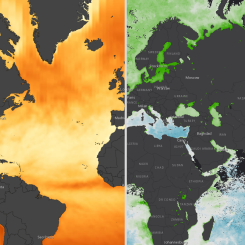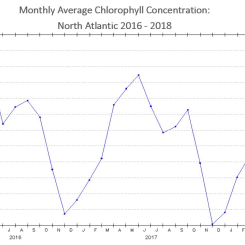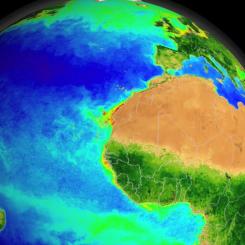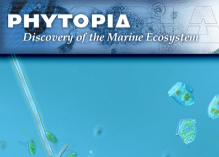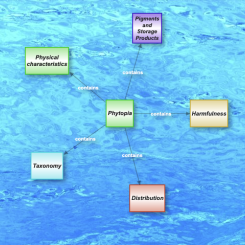Global Phytoplankton Distribution
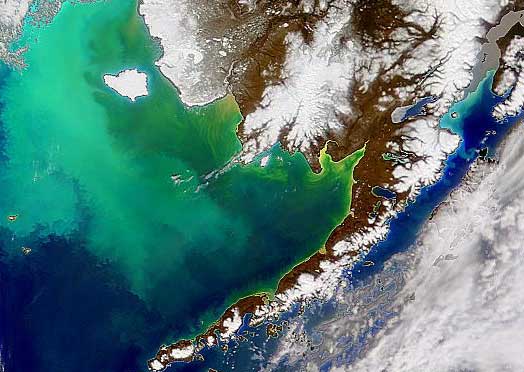
What are Phytoplankton?
Derived from the Greek words phyto (plant) and plankton (made to wander or drift), phytoplankton are microscopic organisms that live in watery environments, both salty and fresh.
Some phytoplankton are bacteria, some are protists, and most are single-celled plants. Among the common kinds are cyanobacteria, silica-encased diatoms, dinoflagellates, green algae, and chalk-coated coccolithophores. As we will learn here, the tiniest of living organisms exert an outsized influence on the planet.

Phytoplankton are extremely diverse, varying from photosynthesizing bacteria (cyanobacteria), to plant-like diatoms, to armor-plated coccolithophores (drawings not to scale). (Collage adapted from drawings and micrographs by Sally Bensusen, NASA EOS Project Science Office.)
What do phytoplankton need to survive and where are they located?
Like land plants, phytoplankton growth depends on the availability of sunlight, carbon dioxide, and nutrients. Phytoplankton are found where each of these factors are abundant. Phytoplankton live in the surface waters of the ocean, where there is usually ample light for phytoplankton to grow in the surface waters and carbon dioxide dissolved in oceans is freely available. Like land plants, phytoplankton have chlorophyll to capture sunlight, and they use photosynthesis to turn it into chemical energy (food). Carbon dioxide is plentiful in the ocean. Whenever the supply in the surface waters goes down because the phytoplankton have used it during photosynthesis, it is replenished from the atmosphere above. They consume carbon dioxide and release oxygen. All phytoplankton photosynthesize, but some get additional energy by consuming other organisms.
The major limiting factor regulating phytoplankton growth is the availability of nutrients. This is why phytoplankton are much more abundant in some areas of the ocean compared to others. Phytoplankton need similar nutrients to land plants. Important nutrients include nitrate, phosphate, silicate, and calcium at various levels depending on the species. These nutrients can come from the following sources. NOTE: Other factors influence phytoplankton growth rates, including water temperature and salinity, water depth, wind, and what kinds of predators are grazing on them.
- Ocean floor carried to the surface on upwelling currents - Most nutrients are found in great quantities in the deeper, colder depths of the ocean. Whenever those waters are brought near the surface, upwelling, the oceans are essentially fertilized (just like you do to your lawns to green them up) and the plankton bloom.
- River runoff - Not surprisingly, high chlorophyll concentrations line the coasts where such nutrients wash into the ocean from the land. Nutrients fuel that these coastal blooms are brought in from inland sources through water flowing from the land to the sea. This runoff may carry fertilizers and other nutrients applied to agricultural fields, providing phytoplankton the nutrients needed to thrive and bloom.
- Wind-blown dust - Dust can contain soluble iron, which is an essential nutrient for phytoplankton growth and development.
Phytoplankton live where sunlight, carbon dioxide, and nutrients are plentiful. When conditions are right, phytoplankton populations can grow explosively, a phenomenon known as a bloom. Blooms in the ocean may cover hundreds of square kilometers and are easily visible in satellite images. A bloom may last several weeks, but the life span of any individual phytoplankton is rarely more than a few days.
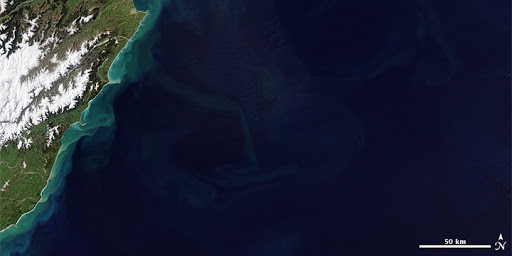 |
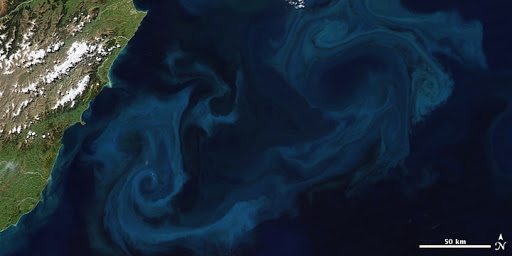 View, download, or analyze more of these data from NASA Earth Observations (NEO): |

Why are Phytoplankton Important in the Earth System?
Biosphere
Phytoplankton—tiny, plant-like cells that turn sunlight into food—are responsible for nearly half of the planet’s primary production. That is, they transform carbon dioxide, sunlight, and nutrients into organic matter.
Phytoplankton are the foundation of the aquatic food web, the primary producers, feeding everything from microscopic, animal-like zooplankton to multi-ton whales. Small fish and invertebrates also graze on the plant-like organisms, and then those smaller animals are eaten by bigger ones. Because the animals all the way up the food chain ultimately depend on the supply of phytoplankton at the base, if the plankton disappear, the chain is broken and eventually, the animals will suffer. Phytoplankton are such important sources of food for many marine animals that waters rich in phytoplankton usually support a thriving, diverse marine ecosystem.
How do Phytoplankton Interact with other Spheres in the Earth System?
Just like plants on land, phytoplankton require light, water, carbon dioxide and nutrients to grow.
Atmosphere - Oxygen Production
Like plants and trees on the land, phytoplankton give us a lot more than food. Phytoplankton are intricately connected to Earth’s atmosphere. During photosynthesis phytoplankton capture and store solar energy through photosynthesis where they remove carbon dioxide from seawater, and release oxygen as a by-product. Through photosynthesis, phytoplankton consume carbon dioxide on a scale equivalent to forests and other land plants. Some of this carbon is carried to the deep ocean floor when phytoplankton die. The carbon in the phytoplankton is soon covered by other material sinking to the ocean bottom. Some is transferred to different layers of the ocean as phytoplankton are eaten by other creatures, which themselves reproduce, generate waste, and die.
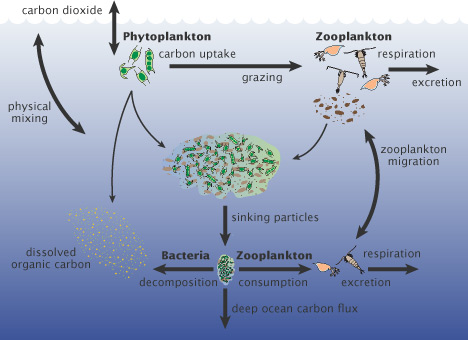
Phytoplankton are responsible for most of the transfer of carbon dioxide from the atmosphere to the ocean. Carbon dioxide is consumed during photosynthesis, and the carbon is incorporated in the phytoplankton, just as carbon is stored in the wood and leaves of a tree. Most of the carbon is returned to near-surface waters when phytoplankton are eaten or decompose, but some falls into the ocean depths.
There are many trillions of phytoplankton in the sea, and together they convert huge quantities of carbon dioxide (CO2) into living matter. In that process, they release a major percentage of the world's oxygen into the atmosphere. Every day, more than 100 million tons of carbon dioxide are drawn from the atmosphere into the ocean by billions of phytoplankton during photosynthesis.
Scientists estimate that at least 50 percent of the oxygen in our atmosphere has been produced by phytoplankton. At the same time, they are responsible for drawing down significant portions of the carbon dioxide from the air. This allows the oceans to absorb additional carbon dioxide from the atmosphere. If fewer phytoplankton existed, atmospheric carbon dioxide would increase.
Worldwide, this “biological carbon pump” transfers about 10 gigatonnes of carbon from the atmosphere to the deep ocean each year. Even small changes in the growth of phytoplankton may affect atmospheric carbon dioxide concentrations, which would feed back to global surface temperatures.
Geosphere - Short and Long-term Carbon Cycle
Although phytoplankton account for approximately 50% of the photosynthesis on this planet, over 99.9% of all the carbon dioxide that has been incorporated into living things over geologic time is buried in marine sediments, indicating that phytoplankton play a very important part in regulating the amount of carbon in the atmosphere.
In addition to their role with other phytoplankton as the base of the marine food web, coccolithophores also have an important place in Earth’s climate system. The scales contain carbon, and any scales that aren’t digested by other organisms sink to the ocean floor and become part of the sediment—a long-term sink of carbon.
Cryosphere - Melting Sea Ice
Phytoplankton are also affected by Earth’s cryosphere. As Earth’s temperatures warm, the melting sea ice affects these protists. Phytoplankton, grow in the top layer of the ocean. Like all plants, they need sunlight to grow. When there's less ice, the sunlight can shine through the water better.
Cycling of Energy & Matter
NASA scientists observe a trend of warming sea surface temperatures, which cause a global decline in phytoplankton productivity. In general, the reverse situation is also true: where temperatures cooled, productivity rose. Why do warmer temperatures have a negative influence on phytoplankton growth?
The patterns of distribution of phytoplankton that we observe are related to both physical and biological processes.The most likely explanation is that the warmer the surface waters become, the less mixing there is between those waters and deeper, more nutrient-rich water. As nutrients become scarce at the surface, where phytoplankton grow, productivity declines. In this situation, with “lighter” (i.e., less dense) water on top, and “heavier” (denser) water below, there is little vertical mixing, and nutrients can’t move to the surface. As surface water warms, the stratification, or layering, becomes even more pronounced, suppressing mixing even further. As a result, nutrient transfer from deeper water to surface waters declines, and so does phytoplankton productivity.
How Do We Measure Phytoplankton?
The oceans cover 70 percent of Earth. Because those waters are too vast for anyone to explore completely and too opaque to see through with cameras, we still have a lot to learn about them. One thing we do know is that the ocean is teeming with floating, drifting life, mostly microscopic.
Phytoplankton are single celled organisms which far outnumber the sum of all the marine organisms most of us think of first. Individual phytoplankton are tiny, but when they bloom by the billions, the high concentrations of chlorophyll and other light-catching pigments change the way the surface reflects light and produce colorful patterns in the water. From space, ocean scientists have a wide-angle view. They can see the colors of the sea (it’s not all deep blue). They can detect the intensity of plant pigments—mostly chlorophyll (the energy-producing pigment that give plants their green color)—in the water. The water may turn greenish, reddish, or brownish. The chalky scales that cover coccolithophores are made out of calcium carbonate, are very reflective; they often give the water a bright, turquoise glow.
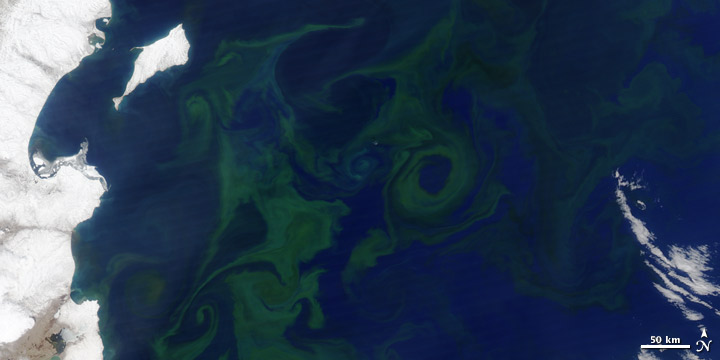
|
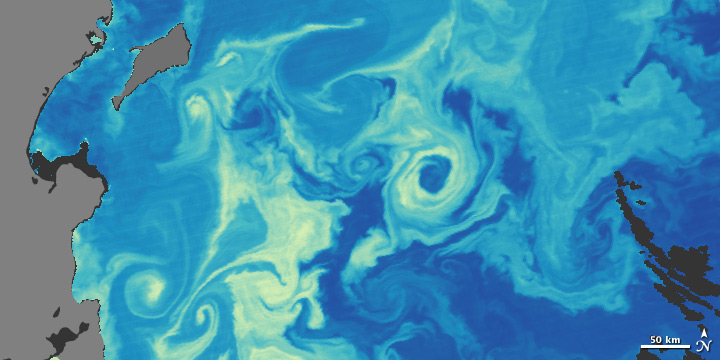
|
Over the past three decades, satellites have been measuring the color of the oceans. Seawater changes from blue to green as the abundance of phytoplankton in the water increases. Researchers have used this phenomenon as recorded in the satellite color data to determine the total quantity of phytoplankton in the world's oceans. Though it is very difficult to identify the genus and species of phytoplankton from a satellite, researchers working from ships collect samples to verify the data collected by satellites. These measurements give scientists valuable insights into the health of the ocean environment and help scientists study the ocean carbon cycle.
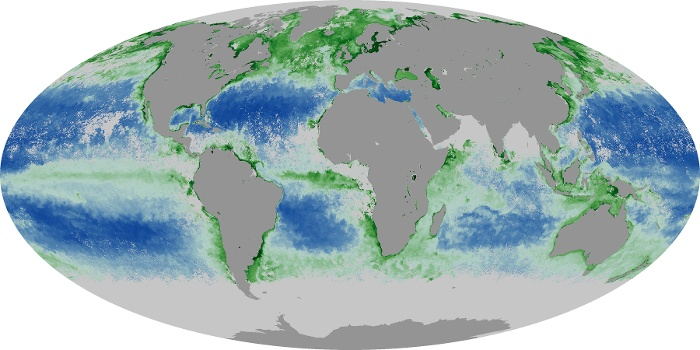
Scientists use NASA satellites to generate chlorophyll maps like this to analyze phytoplankton distribution over the global ocean. This map show milligrams of chlorophyll per cubic meter of seawater each month. Places where chlorophyll amounts were very low, indicating very low numbers of phytoplankton are blue. Places where chlorophyll concentrations were high, where many phytoplankton were growing, are dark green. The observations come from the Moderate Resolution Imaging Spectroradiometer (MODIS) on NASA's Aqua satellite. Land is dark gray, and places where MODIS could not collect data because of sea ice, polar darkness, or clouds are light gray. Such global maps also give scientists an idea of how much carbon the plants are soaking up, which is important in understanding the global carbon budget.
To continue this initiative of exploring our oceans, NASA's PACE (Plankton, Aerosol, Cloud, ocean Ecosystem) Mission will prove valuable in measuring the distribution of phytoplankton using the Ocean Color Instrument, which is a spectrometer that measures intensity of light over portions of the electromagnetic spectrum at smaller wavelengths than previously possible with other NASA ocean color sensors. This capability will enable NASA to monitor global phytoplankton distribution and quantities, helping us to understand the complex systems that drive ocean ecology, and assessing the overall health of our oceans. Phytoplankton are a key component of the marine food web, playing an extremely important role in the balance of Earth’s web of life.
What Phenomena are Associated with Chlorophyll?
Blooms, Dead Zones, Harmful Algal Blooms
Phytoplankton are an important source of food for many marine animals, so waters that are rich in phytoplankton usually support a thriving ecosystem. But in some cases, phytoplankton blooms can be deadly to the very ecosystem they typically support.
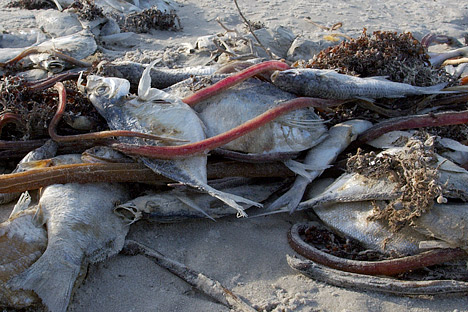
Dead fish washed onto a beach at Padre Island, Texas, in October 2009, following a harmful algal bloom. (Photograph ©2009)
When phytoplankton growth is stimulated by an overabundance of nutrients from sources such as sewage discharge or runoff of agricultural fertilizers used on land, the consequences can be quite serious. Dense blooms of phytoplankton can essentially block sunlight from reaching the bottom in shallow areas of bays or estuaries and can cause the massive decline in the Submerged Aquatic Vegetation (SAV) found in places like the Chesapeake Bay. These grasses are vital nursery grounds for many species of fish and invertebrates and their loss can have dire ecological results.
In the aftermath of a massive bloom, dead phytoplankton sink to the ocean or lake floor. The bacteria that decompose the phytoplankton consume all of the oxygen in the water. Fish, shellfish and most other living things that require oxygen to survive suffocates during these periods of decay, resulting in Dead Zones in the ocean—oxygen-poor regions where fish cannot survive.
Other ways that phytoplankton negatively impact ocean waters are blooms of certain species of phytoplankton that produce powerful biotoxins. An example of these toxic blooms are harmful algal blooms (HAB’s). HAB events have been documented as far back as the 1840s and are notorious for having strong smells, as well as cause eye, nose, and throat irritations, and fish kills. These toxic blooms can kill marine life and people who eat contaminated seafood.
Credits:
- NASA Climate Kids: Winners and Losers in the Arctic
- The Mathematical Ocean: Deriving Planetary Health from Tiny Ocean Plants
- NASA Earth Observatory:
- Carbon: Where does it all go?
- Visible Earth:
Disciplinary Core Ideas:
Crosscutting Concepts:
- Scale, Proportion, and Quantity
- Systems and System Models
- Structure and Function


